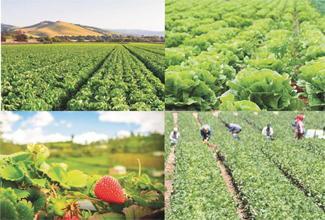Another commodity trend, also spurred by the eat-healthy mantra, is a steady increase in growing organics. “Organics are huge in the consumer market,” asserts Ken Balestrieri, president of K. Balestrieri Company, Inc. “People are turning towards organics because they recognize the safety, and want a food source that doesn’t have the applications [pesticides] used in monoculture products.”
Bengard’s Kaslin admits, “We’re not into organics yet,” but says the company is “looking at it seriously. The demand appears to be increasing, and chain stores say that business is growing, while most everything else is about the same.”
Even with increasing demand, starting organic production requires a significant investment. Growers cannot label crops as ‘organic’ until the third year of production, and only after using organic seeds, no commercial pesticides, with clearly delineated lots, restrictions on composting, and a host of other requirements. Organic farms are also subject to rigid inspections and tend to be more labor-intensive, yet despite the steep requirements, market demand is creating opportunity for more production.
Similar to Kaslin’s remarks, Green Star Produce Marketing’s vice president Joe Sherer says, “We haven’t grown organic yet, but that could be around the corner. The need is there, and more and more farmers are getting into it.”
Water, or the Lack Thereof
Probably the greatest current issue for Salinas farmers is the ongoing drought and dropping water table. In mid-February the U.S. Department of Agriculture (USDA) declared 55 California counties as primary natural disaster areas, due to losses caused by drought. This included Monterey and surrounding areas like the San Joaquin Valley, which relies on surface water from reservoirs and aqueducts. Salinas is at least fortunate to be fed mainly by wells. Rain, of course, is always hoped for—and though torrential downpours arrived in February, they were to the north, and did not reach the Valley.
To combat the shortfall, growers are putting a variety of measures in place from drip irrigation to sensors on plants and meters on wells to track water usage. Another worry is possible contamination of the water sources growers do have. “The aquifers here are struggling and more and more wells are going to get salt water intrusion,” Armstrong predicts. “Some farmers are spending upwards of $2 million to dig their wells deeper.”
As a generational farmer, Armstrong says when he was a kid, wells were dug at 180 feet and accessed plenty of water. As the years have gone by and both population and farming increased, wells deepened to 440 feet, and today, some are drilling down in excess of 1,700 feet. “One of the real struggles is the infrastructure the state has for holding water,” he explains. “There’s a tug-of-war over rebuilding dams and dredging canals. It’s a capacity problem—in December we had 4.5 inches of rain, but most of that ran off into the ocean.”



